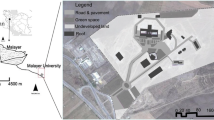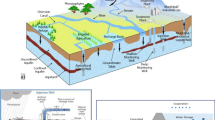Abstract
Cities in arid and semiarid regions face the dual challenges of managing urban floods and water shortages, threatening their sustainability. Urban areas are particularly vulnerable to flooding despite minimal rainfall and are prone to drought. This is evident in the capital of Afghanistan, Kabul, where groundwater decline and urban floods pose severe challenges. This study investigates the possibility of utilizing rainwater harvesting (RWH) to manage urban floods and recharge groundwater. The research examines various aspects of rainfall patterns, such as variability, rainy days, seasonality, probability, and maximum daily precipitation. The analysis of precipitation statistics reveals that rainfall exceeding 30 mm occurs approximately every 3–4 years. Rainfall in Kabul follows a seasonal pattern, with a coefficient of variation of 127% in October and 46% in February during the wet period. The study then assesses the potential of RWH in Kabul City as a solution for stormwater management and groundwater recharge. Based on the typology of land use and land cover, implementing a rainwater harvesting and recharge system (RWHRS) could increase mean annual infiltration from 4.86 million cubic meters (MCM) to 11.33 MCM. A weighted Curve Number (CN) of 90.5% indicates impervious surfaces’ dominance. The study identifies a rainfall threshold of 5.3 mm for runoff generation. Two approaches for collecting rainwater for groundwater recharge are considered: RWHRS for a residential house with an area of 300m2, which yields approximately 88m3/year, and RWHRS for a street sidewalk to collect water from streets and sidewalks. These findings highlight the potential of RWHRS as an effective strategy for managing urban floods and recharging groundwater artificially.










Similar content being viewed by others
Data Availability
The data used in the current research will be available through the corresponding author based on request.
References
Ahmadzai H, Omuto C (2019) Afghanistan soil catalogue. FAO, Kabul, Afghanistan
B R PB, Lokeshwari M (2021) Potential of rain water harvesting and Ground Water Improvement at RVCE. Glob Jounal Res Eng C Chem Eng 21
Brati MQ, Ishihara MI, Higashi O (2019) Groundwater level reduction and pollution in relation to household water management in Kabul, Afghanistan. Sustain Water Resour Manag 5:1315–1325. https://doi.org/10.1007/s40899-019-00312-7
DACAAR (2019) Hydro-geological Booklet Kabul Province. DACAAR, Kabul, Afghanistan
Dhakate R, Rao VVSG, Raju BA et al (2013) Integrated Approach for identifying suitable Sites for Rainwater Harvesting Structures for Groundwater Augmentation in Basaltic Terrain. Water Resour Manag 27:1279–1299. https://doi.org/10.1007/s11269-012-0238-3
Gado TA, El-Agha DE (2020) Feasibility of rainwater harvesting for sustainable water management in urban areas of Egypt. Environ Sci Pollut Res 27:32304–32317. https://doi.org/10.1007/s11356-019-06529-5
Ghazavi R, Babaei S, Erfanian M (2018) Recharge Wells Site Selection for Artificial Groundwater recharge in an urban area using fuzzy logic technique. Water Resour Manag 32:3821–3834. https://doi.org/10.1007/s11269-018-2020-7
Gwenzi W, Nyamadzawo G (2014) Hydrological impacts of urbanization and urban roof Water Harvesting in Water-limited catchments: a review. Environ Process 1:573–593. https://doi.org/10.1007/s40710-014-0037-3
Huang Z, Nya EL, Rahman MA et al (2021) Integrated water resource management: rethinking the contribution of rainwater harvesting. Sustain 13:1–9. https://doi.org/10.3390/su13158338
Hussain F, Hussain R, Wu RS, Abbas T (2019) Rainwater harvesting potential and utilization for artificial recharge of groundwater using recharge wells. Processes 7. https://doi.org/10.3390/pr7090623
Jawadi HA, Sagin J, Snow DD (2020) A detailed Assessment of Groundwater Quality in Future Development. Water 1–19. https://doi.org/10.3390/w12102890
Jawadi HA, Iqbal MW, Naseri M et al (2022) Nitrate contamination in groundwater of Kabul Province, Afghanistan : reasons behind and conceptual management framework discourse. J Mt Sci 19:1274–1291. https://doi.org/10.1007/s11629-021-7002-1
JICA (2011) The study on groundwater resources potential in Kabul basin in the islamic republic of Afghanistan final report. JICA
Jung K, Lee T, Choi BG, Hong S (2015) Rainwater Harvesting System for Contiunous Water Supply to the regions with high Seasonal Rainfall Variations. Water Resour Manag 29:961–972. https://doi.org/10.1007/s11269-014-0854-1
Krishna TM, Sudharsan RVK, Sudhangan B D (2021) Water Management through Rainwater Harvesting in Urban Areas. Nat Volatiles Essent Oils 8:6118–6124
Machiwal D, Jha MK, Mal BC (2011) Assessment of Groundwater potential in a Semi-Arid Region of India using remote sensing, GIS and MCDM techniques. Water Resour Manag 25:1359–1386. https://doi.org/10.1007/s11269-010-9749-y
Mack TJ, Akbari MA, Ashoor MH et al (2009) Conceptual Model of Water Resources in the Kabul Basin, Afghanistan. USGS
Mack TJ, Chornack MP, Taher MR (2013) Groundwater-level trends and implications for sustainable water use in the Kabul Basin, Afghanistan. Environ Syst Decis 33:457–467. https://doi.org/10.1007/s10669-013-9455-4
Mahmoud WH, Elagib NA, Gaese H, Heinrich J (2014) Rainfall conditions and rainwater harvesting potential in the urban area of Khartoum. Resour Conserv Recycl 91:89–99. https://doi.org/10.1016/j.resconrec.2014.07.014
Manawi SMA (2020) Urban flooding and waterlogging in the northern. Part of Kabul City
Manawi SMA, Nasir KAM, Shiru MS et al (2020) Urban flooding in the Northern Part of Kabul City: causes and mitigation. Earth Syst Environ 4:599–610. https://doi.org/10.1007/s41748-020-00165-7
Mansell MG (2003) Rural and urban hydrology. Thomas Telford
Martin SL, Hayes DB, Kendall AD, Hyndman DW (2017) The land-use legacy effect: towards a mechanistic understanding of time-lagged water quality responses to land use/cover. Sci Total Environ 579:1794–1803. https://doi.org/10.1016/j.scitotenv.2016.11.158
Matomela N, Li T, Ikhumhen HO (2020) Siting of Rainwater Harvesting potential Sites in Arid or semi-arid Watersheds using GIS-based techniques. Environ Process 7:631–652. https://doi.org/10.1007/s40710-020-00434-7
Nachshon U, Netzer L, Livshitz Y (2016) Land cover properties and rain water harvesting in urban environments. Sustain Cities Soc 27:398–406. https://doi.org/10.1016/j.scs.2016.08.008
Noori AR, Singh SK (2021a) Status of groundwater resource potential and its quality at Kabul, Afghanistan : a review. Environ Earth Sci 80:1–13. https://doi.org/10.1007/s12665-021-09954-3
Noori AR, Singh SK (2021b) Spatial and temporal trend analysis of groundwater levels and regional groundwater drought assessment of Kabul. Afghanistan Environ Earth Sci 80. https://doi.org/10.1007/s12665-021-10005-0
Oliver JE (1980) Monthly precipitation distribution: a comparative index. Prof Geogr 32:300–309. https://doi.org/10.1111/j.0033-0124.1980.00300.x
Pauleit S, Duhme F (2000) Assessing the environmental performance of land cover types for urban planning. Landsc Urban Plan 52:1–20. https://doi.org/10.1016/S0169-2046(00)00109-2
Pell Frischmann (2012) Afghanistan Resource Corridor Development: Water Strategy Final Kabul River Basin Report Version 4.0
Qi Q, Marwa J, Mwamila TB et al (2019) Making rainwater harvesting a key solution for water management: the universality of the Kilimanjaro Concept. Sustain 11:1–15. https://doi.org/10.3390/su11205606
Ranaee E, Abbasi AA, Yazdi JT, Ziyaee M (2021) Feasibility of rainwater harvesting and consumption in a middle eastern semiarid urban area. Water (Switzerland) 13:1–23. https://doi.org/10.3390/w13152130
Sadeghi KM, Kharaghani S, Tam W et al (2019) Green Stormwater infrastructure (GSI) for Stormwater Management in the City of Los Angeles: Avalon Green Alleys Network. Environ Process 6:265–281. https://doi.org/10.1007/s40710-019-00364-z
Sarma R, Singh SK (2021) Simulating contaminant transport in unsaturated and saturated groundwater zones. Water Environ Res 93:1496–1509. https://doi.org/10.1002/wer.1555
Sayl KN, Muhammad NS, Yaseen ZM, El-shafie A (2016) Estimation the physical variables of Rainwater Harvesting System using Integrated GIS-Based remote sensing Approach. Water Resour Manag 30:3299–3313. https://doi.org/10.1007/s11269-016-1350-6
Taher MR, Chornack MP, Mack TJ (2013) Groundwater levels in the Kabul Basin, Afghanistan,2004–2013. USGS
Tiwari K, Goyal R, Sarkar A (2018) GIS-based methodology for identification of suitable locations for Rainwater Harvesting Structures. Water Resour Manag 32:1811–1825. https://doi.org/10.1007/s11269-018-1905-9
Tünnermeier T, Houben DG (2005) Hydrogeology of the Kabul Basin Part I: Geology, aquifer characteristics, climate and hydrography. BGR
Uhl WV, Tahiri MQ (2003) An overview of groundwater resources and challenges. Vincent W. Uhl Uhl. Baron, Rana Associates, Inc., Washington Crossing, PA, USA
USDA (2009) Chapet 7 Hydrologic Soil Groups. In: National Engineering Handbook. Washington DC
Walsh RPD, Lawler DM (1981) Rainfall seasonality: description, spatial patterns and change through Time. Weather 36:201–208. https://doi.org/10.1002/j.1477-8696.1981.tb05400.x
Wu RS, Molina GLL, Hussain F (2018) Optimal Sites Identification for Rainwater Harvesting in northeastern Guatemala by Analytical Hierarchy process. Water Resour Manag 32:4139–4153. https://doi.org/10.1007/s11269-018-2050-1
Zabidi HA, Goh HW, Chang CK et al (2020) A review of roof and pond rainwater harvesting systems for water security: the design, performance and way forward. Water (Switzerland) 12:1–22. https://doi.org/10.3390/w12113163
Zaryab A, Noori AR, Wegerich K, Kløve B (2017) Assessment of water quality and quantity trends in Kabul aquifers with an outline for future drinking water supplies. Cent Asian J Water Res 3:3–11
Acknowledgements
The authors are grateful to the Department of Meteorology, General Directorate of Water Resources, Ministry of Energy, and Water of Afghanistan for providing precipitation data for the study.
Funding
The authors declare that no funds, grants, or other support were received during the preparation of this manuscript.
Author information
Authors and Affiliations
Contributions
All authors contributed to the study’s conception and design. Material preparation, data collection, data analysis, and the first draft of the manuscript were performed by Ali Reza Noori. Prof. S.K. Singh reviewed the work, revised it critically for important intellectual content, and approved the version to be published.
Corresponding author
Ethics declarations
Ethical Approval
Not applicable.
Consent to Participate
Not applicable.
Consent to Publish
Not applicable.
Competing Interests
The authors have no relevant financial or non-financial interests to disclose.
Additional information
Publisher’s Note
Springer Nature remains neutral with regard to jurisdictional claims in published maps and institutional affiliations.
Rights and permissions
Springer Nature or its licensor (e.g. a society or other partner) holds exclusive rights to this article under a publishing agreement with the author(s) or other rightsholder(s); author self-archiving of the accepted manuscript version of this article is solely governed by the terms of such publishing agreement and applicable law.
About this article
Cite this article
Noori, A.R., Singh, S. Rainfall Assessment and Water Harvesting Potential in an Urban area for Artificial Groundwater Recharge with Land Use and Land Cover Approach. Water Resour Manage 37, 5215–5234 (2023). https://doi.org/10.1007/s11269-023-03602-0
Received:
Accepted:
Published:
Issue Date:
DOI: https://doi.org/10.1007/s11269-023-03602-0




